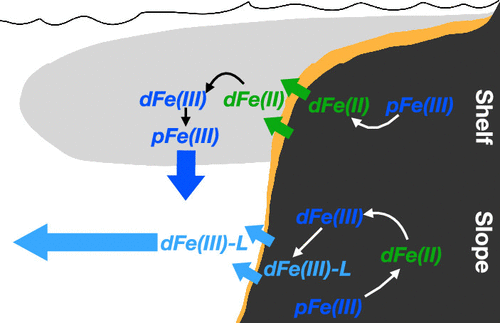当前位置:
X-MOL 学术
›
ACS Earth Space Chem.
›
论文详情
Our official English website, www.x-mol.net, welcomes your
feedback! (Note: you will need to create a separate account there.)
Unexpected Source and Transport of Iron from the Deep Peru Margin
ACS Earth and Space Chemistry ( IF 2.9 ) Pub Date : 2020-05-29 , DOI: 10.1021/acsearthspacechem.0c00066 Phoebe J. Lam 1 , Maija I. Heller 2, 3 , Paul E. Lerner 4 , James W. Moffett 5 , Kristen N. Buck 6
ACS Earth and Space Chemistry ( IF 2.9 ) Pub Date : 2020-05-29 , DOI: 10.1021/acsearthspacechem.0c00066 Phoebe J. Lam 1 , Maija I. Heller 2, 3 , Paul E. Lerner 4 , James W. Moffett 5 , Kristen N. Buck 6
Affiliation

|
Iron is the most important micronutrient in the ocean, but the nature and magnitude of its sources and sinks to the ocean are poorly constrained. Here we assess our understanding of the sources and sinks of iron in margin environments by synthesizing observations from the U.S. GEOTRACES GP16 Eastern Tropical Pacific Zonal Transect (EPZT) cruise near the Peru margin. GP16 observations showed elevated dissolved iron (dFe) concentrations along the margin, but a larger westward plume of dFe at slope depths (1000–3000 m) in oxygenated waters, rather than at shelf depths (100–300 m) in oxygen deficient waters. We examine the potential explanations for this unexpected observation. Multiple tracers from GP16 suggest that sediment resuspension was important at slope depths, which would lead to enhanced benthic flux of dFe above what was previously measured. The difference in the apparent persistence and penetration of shelf versus slope plumes of dFe into the interior of the ocean likely results from faster removal rates of the shelf dFe compared to slope dFe. The dFe sourced from the shelf was almost entirely in the dFe(II) form, whereas dFe sourced from the slope was almost entirely in the dFe(III) form. Although benthic dFe(II) diffuses into oxygen deficient overlying waters, there is still oxidation of dFe(II), which precipitates to particulate Fe(III). In contrast, the slope plume appears to persist in a stabilized dFe(III) form. We hypothesize that sediment porewaters with moderate organic carbon delivery to sediments and shallow oxygen penetration are especially good sources of persistent dFe to the water column.
中文翻译:

秘鲁深缘的铁的意外来源和运输
铁是海洋中最重要的微量营养素,但其来源和汇入海洋的性质和大小受到的限制很有限。在这里,我们通过综合秘鲁边界附近的美国GEOTRACES GP16东部热带太平洋带状断面(EPZT)航行的观测资料,来评估对边缘环境中铁的来源和吸收的了解。GP16的观测结果显示,沿边缘的溶解铁(dFe)浓度升高,但是在含氧水的斜坡深度(1000–3000 m)处而不是在缺氧水域的架子深度(100–300 m)处较大的dFe向西羽状流。我们研究了这种意外观察的潜在解释。GP16的多个示踪剂表明,沉积物的重悬在斜坡深度很重要,这将导致dFe底栖通量增加,超过先前的测量值。dFe的堆积和倾斜羽流向海洋内部的表观持久性和渗透率的差异可能是由于与倾斜dFe相比,dFe去除速度更快。来自架子的dFe几乎完全呈dFe(II)形式,而来自斜坡的dFe几乎完全呈dFe(III)形式。虽然底栖的dFe(II)扩散到上层缺氧的水中,但dFe(II)仍然存在氧化,沉淀成颗粒的Fe(III)。相反,倾斜羽状流似乎以稳定的dFe(III)形式存在。我们假设具有适度有机碳输送到沉积物和浅层氧气渗透的沉积物孔隙水尤其是持久性dFe进入水柱的良好来源。
更新日期:2020-07-16
中文翻译:

秘鲁深缘的铁的意外来源和运输
铁是海洋中最重要的微量营养素,但其来源和汇入海洋的性质和大小受到的限制很有限。在这里,我们通过综合秘鲁边界附近的美国GEOTRACES GP16东部热带太平洋带状断面(EPZT)航行的观测资料,来评估对边缘环境中铁的来源和吸收的了解。GP16的观测结果显示,沿边缘的溶解铁(dFe)浓度升高,但是在含氧水的斜坡深度(1000–3000 m)处而不是在缺氧水域的架子深度(100–300 m)处较大的dFe向西羽状流。我们研究了这种意外观察的潜在解释。GP16的多个示踪剂表明,沉积物的重悬在斜坡深度很重要,这将导致dFe底栖通量增加,超过先前的测量值。dFe的堆积和倾斜羽流向海洋内部的表观持久性和渗透率的差异可能是由于与倾斜dFe相比,dFe去除速度更快。来自架子的dFe几乎完全呈dFe(II)形式,而来自斜坡的dFe几乎完全呈dFe(III)形式。虽然底栖的dFe(II)扩散到上层缺氧的水中,但dFe(II)仍然存在氧化,沉淀成颗粒的Fe(III)。相反,倾斜羽状流似乎以稳定的dFe(III)形式存在。我们假设具有适度有机碳输送到沉积物和浅层氧气渗透的沉积物孔隙水尤其是持久性dFe进入水柱的良好来源。











































 京公网安备 11010802027423号
京公网安备 11010802027423号